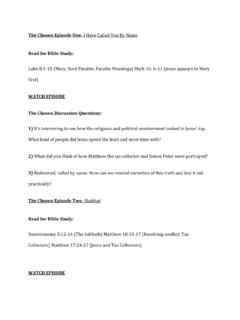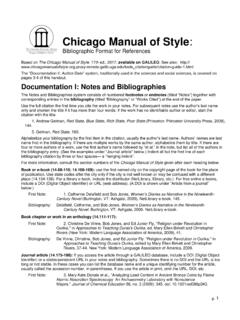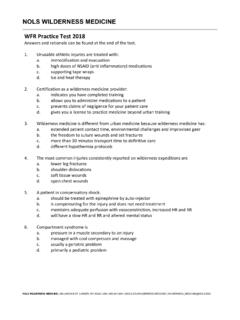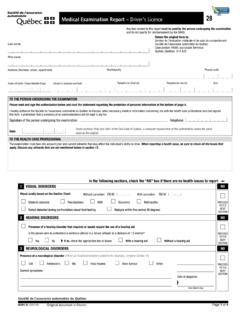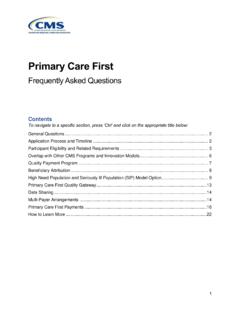Transcription of John Williams ‘Main title/Rebel Blockade Runner’ from Star ...
1 Note: These set works guides are Pearson s interpretation of the set works and every effort has been made to ensure these are appropriate for use in the classroom. There may be other interpretations which are also valid and any such differences would not be considered errors, or require any updates to the guides. John Williams Main title/Rebel Blockade Runner from Star Wars: episode IV A New Hope (for component 3: Appraising) Background Information and Performance Circumstances John Williams (born 1932) is widely considered to be one of the greatest film composers of all time. His scores have been nominated for many awards, and he has (so far) won no less than five Academy Awards (Oscars).
2 He has collaborated with some of the greatest directors (Steven Spielberg, George Lucas) on many iconic films (Jaws, The Star Wars series, Indian Jones series, Schindler s list, three Harry Potter films and Jurassic Park) Williams revitalised and re-popularised the use of grand late-Romantic orchestral scores in movies from the 1970s onwards, when the whole genre was under threat from contemporary and pop-influenced styles. His musical technique lies in the tradition of Korngold and Max Steiner, with a late nineteenth century approach to melody, harmony and orchestration at the root of his musical style. In particular, Williams used the Romantic device, pioneered by Richard Wagner in his operas, of Leitmotif where a character or idea is represented by the same musical idea whenever they appear or are mentioned.
3 The opening theme of the Main title, for example, is associated with Luke Skywalker, and with ideas of heroism and struggle. It is common for film composers to employ orchestrators (people who distribute the composer s melodies and harmonies around the instruments of the orchestra) and in this case Herbert Spencer was responsible for the detailed scoring, under supervision from John Williams . Performing Forces and their Handling Main title/Rebel Blockade Runner uses a full symphony orchestra, (an ensemble which had developed during the nineteenth century and which, by the early twentieth century, often included upwards of sixty players across the four sections Strings, Woodwind, Brass and percussion) Note: These set works guides are Pearson s interpretation of the set works and every effort has been made to ensure these are appropriate for use in the classroom.
4 There may be other interpretations which are also valid and any such differences would not be considered errors, or require any updates to the guides. o 3 Flutes (3rd also playing Piccolo) 2 Oboes, 2 Clarinets, Bass Clarinet, 2 Bassoons o 4 Horns, 3 Trumpets, 3 Trombones and Tuba o Timpani, Triangle, Snare Drum, Tam-Tam, Glockenspiel, Vibraphone and Cymbals o Piano/Celeste and Harp o Strings Traditional symphonic/Romantic treatment of the orchestra with much doubling of parts (more than one instrument playing a particular idea at once, sometimes an octave or more apart) Relatively few uses of solo timbres or lighter textures mostly quite thickly scored Williams avoids the use of any electronic effects or of synthesisers in this score a surprising decision perhaps, particularly in the late 1970s, when such technology was so important in popular music, and had been used in many film scores, especially those with a futuristic theme.
5 1-3 Introduction Dominated by Fanfare-like figures in the brass. Rapid repeated notes develop quickly into staccato triplet figures, with free imitation between Trombones and Trumpets Inverted tonic pedal played tremolando in the Violins In Quadruple time Played ff 4-7 Main theme (A) Heroic leitmotif/main theme, played by high Trumpets Punctuating syncopated (offbeat) chords in Brass/lower strings/Bassoons with rhythm emphasised by snare drum Upper woodwind and violins play tremolando chords and continue inverted tonic pedal from Introduction Played ff 8-113 Main theme repeated (A) Trumpets play melody again Inverted tonic pedal idea varied by semiquaver lower auxiliary figure on alternate beats Accompaniment changed slightly to allow a descending bass 114- 20 Contrasting section (B) Contrasting melody played by all strings apart from Double basses doubled across three octaves Important notes of the melody picked out in the Glockenspiel Accompanying block chords in Horns/Piano (LH)/Oboe Harmony reinforced by triplet figures in Piano (RH)/Harp/Flute/Clarinet Note.
6 These set works guides are Pearson s interpretation of the set works and every effort has been made to ensure these are appropriate for use in the classroom. There may be other interpretations which are also valid and any such differences would not be considered errors, or require any updates to the guides. Bars 12-15 Dominant pedal in Bass instruments Played mf 21-29 Main theme (A) played twice Melody doubled across three octaves in Violin/Viola/Cello/Horn/Trumpet Rushing upwards scale-like passages in woodwind Punctuating syncopated (offbeat) chords similar to those in bars 4-7 Harp glissando at bar 29 provides an effective link to next section Played ff 30-32 Link Fanfare-like material, related to the Introduction, building up a chord using repeated quaver/triplet semiquaver rhythm Rapid ascending (rising)
7 Sequential figures in Strings/Bassoons/Flutes 33-35 Transition Strange, unstable harmonies sustained by Brass and woodwind Rapid arpeggio (broken chord) figures in strings General diminuendo (lessening of volume) 36-38 Star-filled sky Much lighter texture played pp at first Piccolo melody accompanied by held chords/arpeggios in woodwind/Vibraphone/Harp/Celeste/Violin 39-41 Appearance of planets and increase in tension Scurrying upward figures in strings Block chords build up and crescendo (increase in volume) in Trombones and Horns 42-43 Spaceship appears Low C pedal played ff by bass instruments and accompanied by huge Tam-tam (gong) stroke Timpani hammers out an ominous rhythm Brass play two chordal figures which represent the Imperial forces 44-50 Larger spaceship in pursuit firing at the first Dissonant (clashing) chords, played in rhythmic unison, across the orchestra ff ritardando (slowing down)
8 And a pause emphasise effect here change to triple time 51-60 Battle continues and action then switches to inside the rebel craft fast Tempo Strings/lower Brass and woodwind play an Ostinato figure on the note C Brass and upper woodwind play dramatic triads, similar to those heard in 42/43, to accompany shots of the Imperial forces Note: These set works guides are Pearson s interpretation of the set works and every effort has been made to ensure these are appropriate for use in the classroom. There may be other interpretations which are also valid and any such differences would not be considered errors, or require any updates to the guides.
9 The sustained low C fades away in Cello/Bass/Bass Clarinet as the cue ends Texture This extract is dominated by various types of homophonic (tune and accompaniment) texture o Both the Main them A and its contrasting melody B are largely accompanied by block chords, arpeggios or rhythmic articulations of chords o From bar 4 onwards the texture is mostly melody-dominated homophony, with the (often) octave doubled tune supported by block or articulated chords For more details of the variety of orchestral textures used in this extract please see Performing forces table (above) A variety of pedal textures are used in this extract o Inverted tonic pedal in the Introduction and during the first playing of the Main Title Theme o Dominant pedal from bars 12-15 Ostinato textures 51-60.
10 Structure The structure of this extract is intended to match and reinforce the opening section of the film 1-3 Introduction Star Wars logo appears 4-7 Main theme (A) Crawling text moves across the screen, setting the scene for the film 8-113 Main theme repeated. (A) Crawling text moves across the screen, setting the scene for the film 114- 20 Contrasting section (B) Crawling text moves across the screen, setting the scene for the film 21-29 Main theme (A) played twice Crawling text moves across the screen, setting the scene for the film 30-38 A black screen is revealed as star- filled space 39-41 The camera pans downwards, revealing two planets , and then a third 42-43 A spaceship comes into view 44-50 Pursued and attacked by a much larger craft 51-60 Action switches to the inside of the Rebel craft Note.










